I design games and interactive activities for use at my day job. I teach people industry-specific material on an introductory level, so that when they apply for a job in the field, they'll have at least a basic understanding of the industry they're entering.
It's always a challenge to develop a game for our typical audience. The vast majority of them - likely 98% - are not hobby game players and haven't played anything more complex than a hardcore game of Sorry! or Uno. That said, I think there's plenty to chew on with this game, as I wanted to streamline the process of learning the material, plus keep everyone engaged to the very end.
Just today I finished my first-draft prototype of what I currently call The Freight Forwarding Game. I wanted to simulate the process of booking space on a shipping vessel coming from different places across the world into some of the more notable ports in the USA. To put it in technical terms, it's a kind of combination of worker placement and area control game.
I wanted to post a couple photographs here both for my own record-keeping as well as to share my recent game design projects.
This photo shows the area map with the six different ports where ships can dock and then offload their cargo. There are multiple spots at each port, but only when a ship is in "Berth 1" can it be offloaded (and the player collects money). For game purposes, each orange cube represents $50.
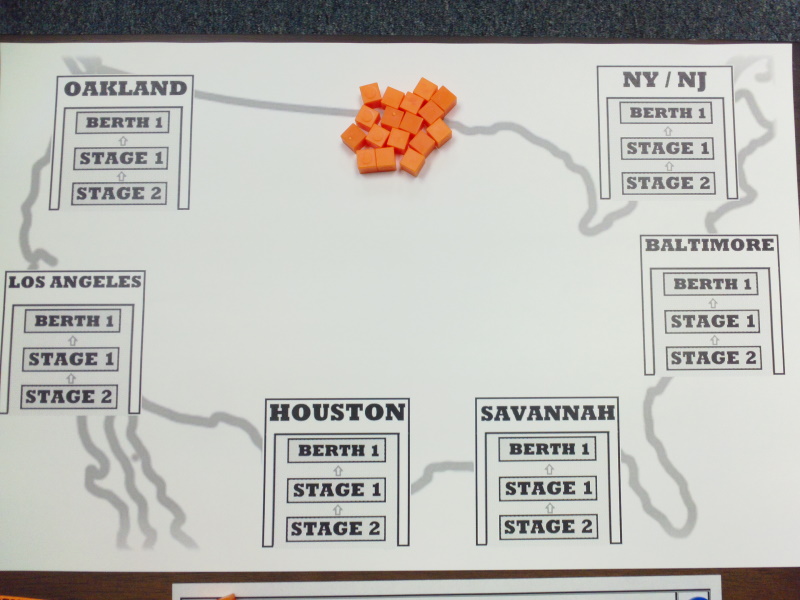
Next photo: Each player manages their own fleet of up to six ships at once. These are wooden shipping vessels and matching player pawns (thanks to The Game Crafter for these pieces...!). Once a player bids on a shipment, they move their ship to the Course Chart and move their matching pawn to the area map. Both the cards used for shipments and the Course Chart are pictured below.
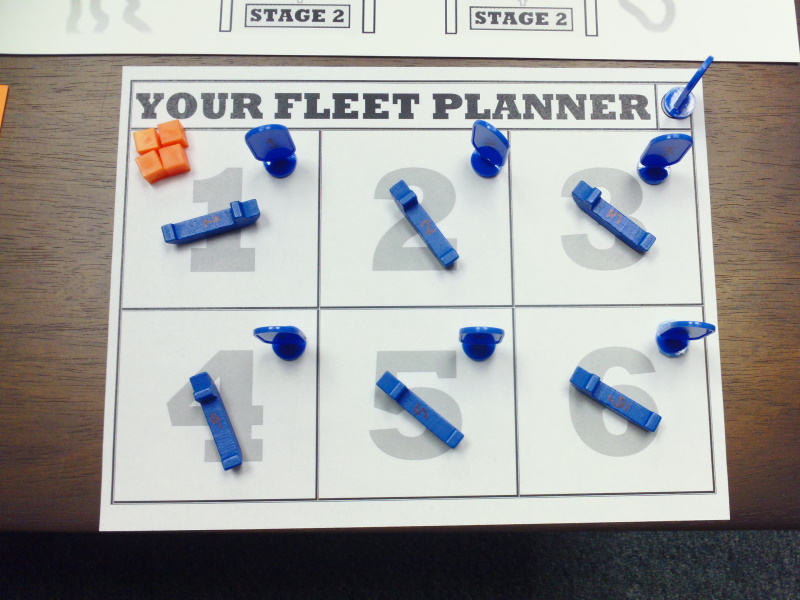
Next photo: Each shipment contract is composed of two cards, each drawn randomly. First, the destination port, found in the USA. Second, the Country of Origin, along with the specific cargo to be carried. To develop these decks of cards, I researched the largest (by area and income) ports in the USA, followed by the USA's top foreign trade partner countries, and the cargo they most-frequently produce and export to the USA.
Once a player bids on a contract, they move the cards for that contract to the space held by the ship used to complete that shipment. This way, the player can track which ships carry what cargo, and how much they'll collect once the ship is unloaded.
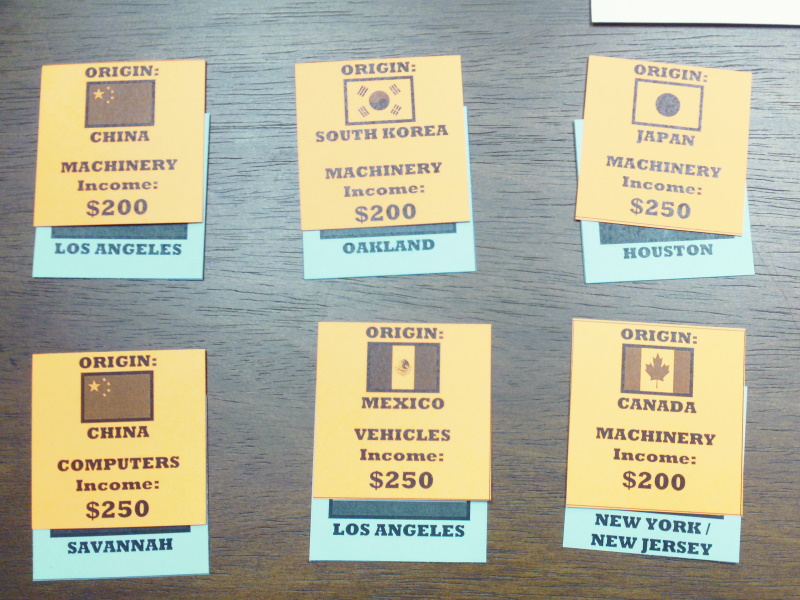
Final photo: This is the Course Chart, which tracks how far away a ship is from its Destination port. Depending on the Country of Origin, some trips take longer than others. For example, those ports on the West Coast of the USA have shorter trips than those on the East Coast, while those to the East are closer to the European Union.
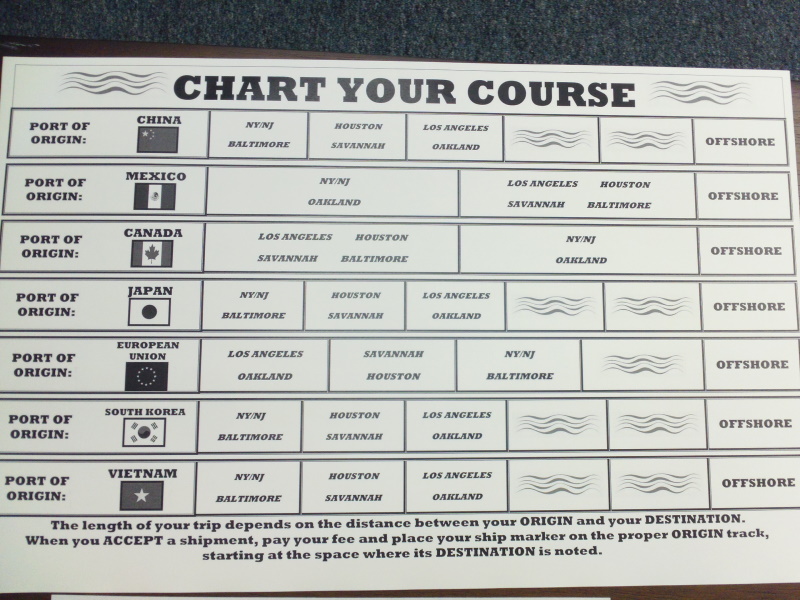
One thing I didn't note yet is there's a turn-order mechanic in the game, preventing lock-ups when more than one ship enters a port at the end of the same turn. Turn order rotates after a certain amount of time, maybe at the start of each turn.
I'm also considering a kind of "favoured port status" or majority bonus of some kind for players who have the most shipments coming from a specific port, or of a specific type of cargo. That's some next-level stuff seriously, so it's doubtful I will be able to implement this for the first version or so.
This is pretty much the MVP (minimum viable product) for the game, and I'll be playtesting this over the next few weeks and into 2022. We have a new cohort coming in January, so I hope most of the bugs are ironed-out before then.



Comments
A few question and comments for you...
Since I actually took a decent look at this design concept (I guess we can call it that since you say there is more work to be done on the game), I wanted to ask a few questions about this idea.
1. I don't understand why the "Port of Origin" is on the LHS and "Offshore" is on the RHS.
2. Furthermore I'm not sure how the "Chart Your Course" works. Is this like you move spaces on this chart?!
Like IF "Port of Origin" is on the LHS, shouldn't there be an "Offshore" next to it immediately with a couple Water Waves and THEN the 3 Destination Ports???!!!
Really don't understand how YOUR version works! And it confuses the heck out of me... And I wanted to reply YESTERDAY ... But I was waiting for anyone else to respond to your thread.
3. $200 and $250 amounts make no sense. Same for the $50 per orange cube. Maybe you should make each orange cube = $5k ($5000). I would upgrade those wooden ships to these PLASTIC ones:
https://www.thegamecrafter.com/parts/ship-space-freighter-green
They can hold 4 8mm Cube. This means that boats can carry from 1 to 4 cubes and since each cube is worth $5k ... $5k to $20k.
4. Too much Machinery... Need better inventory. Could be "Board Games", "Car Accessories", "Fruits" (IDK ...)
5. Six (6) ships is too much. Analysis-Paralysis. Maybe stick to THREE (3) AT MOST.
That's it for now... I hope some of these "critiques" HELP YOU in streamlining your concept a bit. I'm just asking questions and making comments based on my own impressions of what you presented.
Seems cool ... Much too simple. But you are using it as a TEACHING product. So SIMPLE it needs to be... But it needs to MAKE SENSE too.
Note #1: The Port cards could have SQUARES on the very bottom... Indicating HOW MANY "Cubes" can be unloaded per TURN. 3 Square = 3 Cubes per turn (for example).
Keep up the good work... The design may be maturing a bit too!
Note #2: Maybe everyone starts with ONE (1) Ship... And to buy a NEW ship = $100k. The goal is to amass $1M in money in your reserve. That seems like a cool goal... Cheers!
Note #3: If you compute 1 ship + 2 Ships (200k) + 1M = 50+ turns and is MUCH too long.
Maybe introduce more CUBES (not only orange):
1. Red could be Food (1k each)
2. Orange could be Machinery (5k each)
3. Yellow could be Board Games (10k from China ... Hehehe)
4. Green could be Car Accessories (15k each)
5. Blue could be Computers (20k each)
6. Purple could be Vehicles (25k each).
That would be a bit better in the selection process. This seems a bit better but IDK if you want to add such complexity if it is a TEACHING Game. If you want to make it a PLAYABLE "Board Game" ... Then these variations in cubes is pretty important to make the game FLOW!
Cheers...
Thank You & Responses
Wow! I appreciate the time you've spent looking at something in its unforgivably rough beginnings, questcg. :)
I'm back in the office tomorrow and will be tuning this a bit more, and then will likely have something to show for it. Meanwhile, I have some responses to your comments and questions below.
The Course Chart is a simulation of the ocean voyage of that shipping vessel, and it's comprised of seven simple paths that start on the left, and end on the right. The Port of Origin is listed at left. The player looks at the destination printed on their shipment's blue card, and moves their shipping vessel to that spot on the path that matches their Port of Origin.
Consider the "Offshore" space to be "one step away" from the Destination port.
Yep. At the end of your turn, you move one space from the left to the right. If your ship is on "Offshore," you instead move it to the Destination port on the area map. If you have a ship in port at the start of your turn, you reclaim the ship to your Fleet Manager, and collect the money for that completed shipment.
I agree. I was using those cubes because that's what I had on hand at the moment. In the future I'll have paper money. It's something tangible that the players can easily understand as currency and as a way to track their progress/place in the game compared to the other players.
Those choices are deliberate, believe it or not. I did a bit of research on the top imports coming into the United States, as well as the top Countries of Origin for those imports. For instance, obviously China was at the top of that list. Following it were Canada and Mexico. I lumped Germany, the UK, France and Italy into Europe, and further identified them as the European Union (apologies to any Brits who may be reading...)
Good call. I think it's reasonable to reduce fleet size by half, at least to start.
I also strongly agree with your suggestion on those plastic space freighters. I had ordered a bunch of the wooden shipping vessels, but may order the plastic ones instead. I was demonstrating how it was working with my supervisor, and he also suggested finding a way to stack cubes on the ships. It's much easier to manage with those plastic versions. Or maybe I can finagle something with my laser cutter and perhaps glue them to the wooden pieces (which are already being shipped!).
Thanks again for all the input and suggestions, quest! I'm not going totally back to the drawing board, but yeah, this one is -very- early in the process. :)
Update: Revised FFG, version 2
Here are a few modifications made to the original.
This photo: the table has everything needed to play the game. Note that I reduced starting fleets to 3 ships each.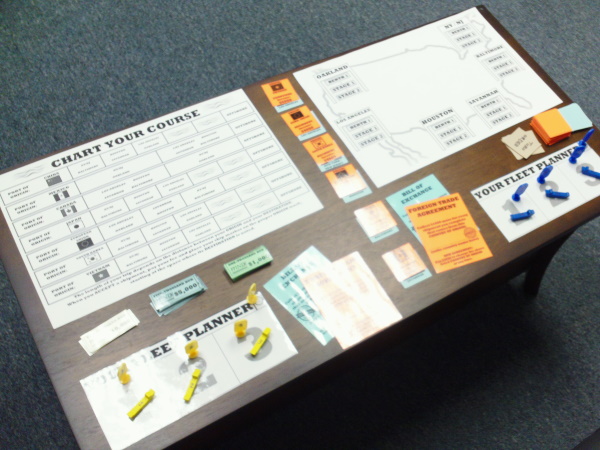
This photo: I have actual funny money now (blocked our organization's logo).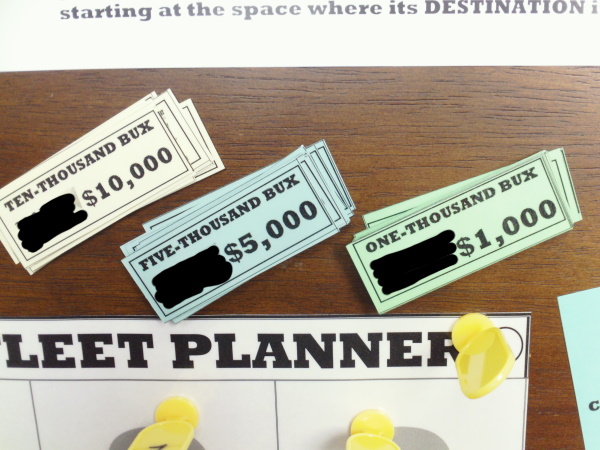
This photo: I'm considering allowing players to earn bonus cash for engaging in Free Trade Agreements (related to specific export countries) and Bill of Exchange (related to specific entry ports, on the USA side). They are able to change this at any time after making their initial selection at the start of the game, though this costs money each time a change is made.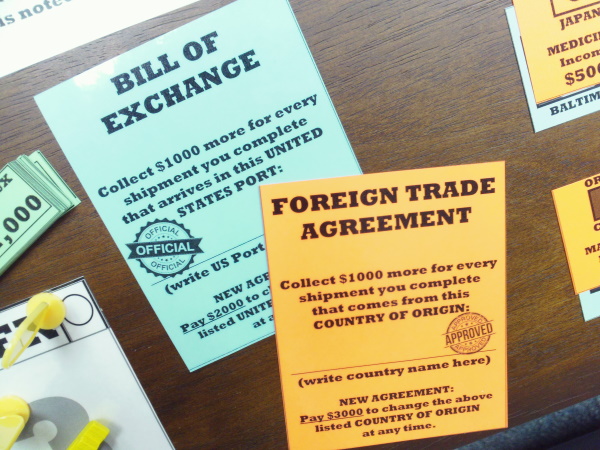
This photo: I modified the dollar values on the cards to represent something a bit more realistic (or engaging, at least) than $50 increments...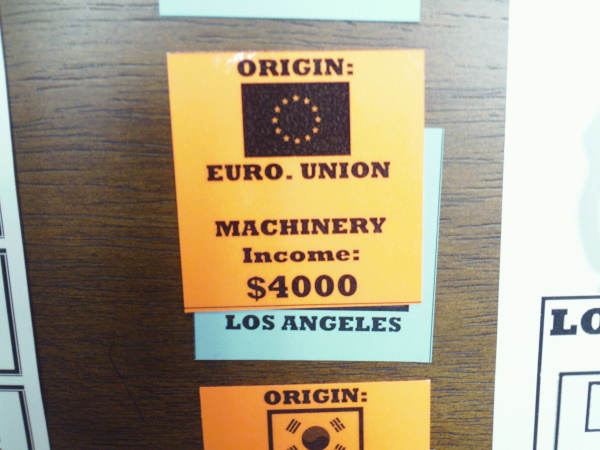
Also considering rules to allow players to expand their shipping fleet at later points in the game. That stuff is still in the works.
Play Aid
This photo: an image of the play aid for the current version. I will be subjecting fellow staff to the roughest playtests. :)
Seriously, this should help players understand what to do when it's their turn. They can skim it between their turns for a reminder. I've set an arbitrary goal of being the first player to reach $20,000 to win the game. We'll see if that works.
Revisions - 14 Dec 2021
Played through a four-player match to the $20K winning condition. Time was about 35 minutes, which is on target.
Everything held together, but it was a bit bland. Going to try some changes for the next iteration.
This will add both some risk and some mildly-interesting strategic decisions to the experience.
These changes will be implemented in my next playtest. We'll see how it goes.
EURO-ish
Definitely has a euro vibe to it, with worker placement and area control. However, the monetary resource stands out as somewhat monopoly-like. Given your general target audience, that may translate the easiest to how they think. But if you were to broaden the scope, for me I'd rather see coins (abstracting the dollar resource), victory or prestige points, and perhaps some other advancement tracks. Something of a La Havre hybrid, obviously with your own spin. But I do like your core concept and think it's brilliant to introduce new gamers to some of these mechanics in a way that's accessible to them!
-Tom
Feedback is Appreciated!
Wow! Le Havre mentioned in a discussion about one of my game designs... You flatterer! :)
Seriously though, I appreciate the suggestions and observations you mention here. Were this for a hobby audience, I would seriously consider much more depth and a more hardcore economic model. As such, I don't plan on making this a Speil des Jahres contender anytime soon, so sticking closer to Monopoly is more likely.
Meanwhile, playtesting has continued with the revisions made after my previous version hit the table. There's now a solid link between port selection, Free Trade Agreements, and occasionally benefiting from Port Logistics.
This image is some of the data collected from a session I ran yesterday. Not sure if it's of interest to anyone, but I did track player order, possible connections between winning and the Free Trade Agreement tokens, and a couple other factors.
This kind of record-keeping is more for my own edification (and perhaps to share with my supervisors to let them know there's a reason I'm fiddling around with game components while at work...), but readers may find it interesting.
Also, I removed the option to book multiple ships during a single turn. It seemed to make realistic sense, but ended up slowing things down too much during playtests. I also wanted to limit analysis paralysis, as questccg alluded to earlier. What remains is neither an obvious nor uninteresting choice, at least most of the time.
Update: 20 Dec 2021
Just a brief note to mention the following:
I also experimented with some end-game variations. For example, the option exists to play out the entire deck of shipment cards, and this can sometimes make a difference in the outcome.
Players can also take turns after shipments have been exhausted so that they complete the shipments they've booked, and -then- tally their final score. It takes longer, but for ultra-competitive grognards it can be satisfying.
I also toyed with the idea that if we're in this end-of-game scenario, anyone whose shipments are all completed simply draws another Free Trade Rebate instead of taking their turn, discarding the -$500 cards (there are a small number of penalty cards in the mix), to reward early completion.
For the purposes of our class sessions, just playing to the original end-game condition was good enough, so that's what I've added to the player aid.